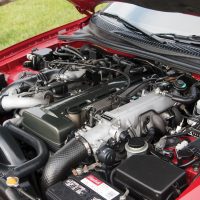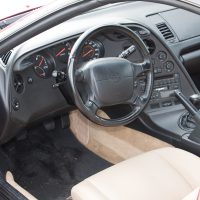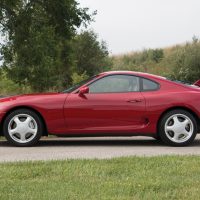- 3.0-liter twin turbo inline 6-cylinder engine
- 6-speed manual transmission
- Reported as one of 431 turbos in this color in 1994
- Aluminum targa roof
- Traction control
- Desirable rear spoiler
- Air conditioning
- Offered in excellent condition
- “Extremely rare stock configuration”
- Clean CARFAX with just over 29,000 actual miles
- Power steering and brakes
- Radio
- Original glass
- Original books, window sticker and extra keys
SCM Analysis
Detailing
| Vehicle: | 1994 Toyota Supra Turbo |
| Years Produced: | 1993–97 Type A80, Series I (MKIV) |
| Number Produced: | 34,275 |
| Original List Price: | Base price was about $45,200, this example was $50,258 |
| SCM Valuation: | Median to date, $23,500; high sale, $199,800 |
| Tune Up Cost: | $500 |
| Chassis Number Location: | VIN tag in front left corner of windshield |
| Engine Number Location: | Front right corner of engine block, near the sump |
| Club Info: | Supra MKIV Owner’s Club |
| Website: | http://www.mkivsupra.net/vbb/content.php |
| Alternatives: | 1995–97 Porsche 993 Carrera, 1986–92 Toyota Supra Turbo, 1970 Datsun 240Z |
| Investment Grade: | C |
This car, Lot 5063, sold for $68,200, including buyer’s premium, at Auctions America’s Auburn sale at Auburn, IN, on September 3, 2016.
Although Auctions America provided a short list of attributes for this 1994 Toyota Supra, it seems obvious it was a very nicely maintained example — without modification. The result, about $70,000 by the time you get it home, seems like a strong price, even for an enthusiastic end user.
Although these cars are rare, there do seem to be some options in both color and mileage on the market. Discerning what they may cost you, however, is a bit trickier.
Scanning eBay, you will find comparable Toyota Supras anywhere from about $30,000 to $100,000 “or Best Offer,” and even several with a “Buy It Now” price anywhere in between. Completed listings paint an even less-discernable picture. Often the same car has been relisted and “sold,” just weeks after a successful “sale” for less. Whether this is against eBay policy or not, I don’t know, but in either case it doesn’t help accurately depict a market.
Back on the market already
Looking among those same eBay pages, you will also find the subject vehicle for sale. This Toyota was, as it appears, bought by Vanguard Motor Sales of Plymouth, MI, and has been listed for sale at $94,900.
The description begins, “I have a confession to make: I’m a ‘Fast and Furious’ fan boy, I realize now I’m showing my age. I grew up with Paul Walker and Vin Diesel racing through the streets of LA. I grew up with stars like the Mitsubishi Evolution, Subaru WRX STI, Dodge Stealth, Mazda RX-7, and of course, the infamous Toyota Supra. There’s something about the sound of a spooling turbo that gets to my core…”
Now, this wasn’t my scene, but I get it. Just around the time I got my driver’s permit, the movie “The Fast and the Furious” hit theaters, and the effect that movie had on my fellow new drivers was notable. Those 106 minutes, packed with burnouts, drifts and street races, did more to change the appearance of a high-school parking lot than any other movie of our generation. And its reach was far broader than this country alone.
Movies, mods and value
Unsurprisingly, when the Toyota Supra driven by Paul Walker in the first film of “The Fast and The Furious” franchise made it to auction at Mecum in May 2015, it sold for nearly $200,000, which, in retrospect, seems well bought. What would the “Bullitt” Mustang bring?
But there is some irony here. The market has taught us that the purest, most-original example is most valued. The enthusiasm for cars like the Toyota Supra, however, is rooted in the desire to alter and modify them. So while the movie car brought a result multiples of the next best data point, it is not a comparable for the Supra market.
Look at Porsches, for example. Countless 911s were modified over the years, and that trend is far from over. But we all know well that modifications don’t usually add value. (Look up what an original exhaust for a 930 Turbo runs these days.)
For a non-original car, value is subjective. The adage in hot rods is that you’ll pay a fortune to build what you want, and it’s rare you see a fraction of it back when it’s time to sell.
But that’s not why people do it. And that is certainly not what kids my age were thinking when they started putting body kits on Honda Civics and larger turbos on Audi A4s.
All of us car enthusiasts actually owe a little credit to the tuner movement. At a time when many were wondering where the future mechanics, restorers and other automotive craftsmen would come from, Vin Diesel and Paul Walker made it cool. And in doing so, they recruited an entire generation.
And, back to the topic, once that generation has some disposable income, cars like this Toyota Supra will only attract the attention of a broader market.
A quality, original car
As for the result, I don’t think we should discredit it because the car sold to the trade. It isn’t the first time — and it won’t be the last time — a car bought at public auction ends up on a dealer website. I may be a bit biased, but it is often those in the trade who can see value the best.
And for quality of example, there is nothing to argue with here. It’s not the absolute lowest-mileage example on the market, but it is a well-kept, original car, the merits of which far exceed the added premium.
The tuner movement left few Toyota Supras, and the like, in unmodified condition. That rarity certainly helps influence a market. It was Toyota who produced the first blue-chip Japanese sports car, and the Supra marked the brand’s continued dedication to motorsport enthusiasts.
To my generation, Toyota is no more “foreign” than BMW. And today, Toyota’s presence as a leading manufacturer is only furthered by their notable presence across motorsport altogether.
I’m looking forward to my high-school friends emailing me links to cars like this Supra and asking for my advice. It will be: “Always buy the best example you can find. It’s worth the extra expense every time.”
But what is that premium? It depends. And that’s the best answer I can come up with. Sometimes its 10%, and other times you’d call me crazy for suggesting it’s 100%.
Having said all that, when we get into the modern era (circa 1990 and on), it’s challenging to differentiate among examples. It’s a mileage, color, clean-CARFAX game.
Defining rare and valuable
Sometimes, I just feel we’re trying to make something out of nothing.
The supercar market, for example, has always perplexed me. (And please realize that what you’re about to read uses gross generalization to stir thought.)
Consider the Ferrari F40. It’s an easy one. Over 1,300 cars were built, they’re (almost) all red, and the differences between the European and U.S. versions are, for purposes of this discussion, negligible. People have paid hundreds of thousands of dollars more, the only discernable advantage being fewer miles.
Don’t get me wrong, there should be a difference, but what is it really worth to boast, “Mine has only 1,100 miles”? That’s hard to answer.
What’s more, in 2016 seemingly anything scarce or interesting is collectible, including some brand-new cars. The result of this sort of thinking will be many low-mileage, “collector-owned” examples in the years to come. We saw this with the 1989 Porsche Speedster; I’d be willing to bet you there are more of those under 10,000 miles than over.
My point being, we need to better qualify rarity, and therefore the premium attached. As with anything collectible, we will ultimately default to rarity. (They only made three in black, or this one has the carbon-fiber package, or so-and-so bought it new…) Let’s just be realistic when putting a price on that sort of thing.
And let’s not forget how much emotion is involved. One of the biggest takeaways from five-plus years at an auction house: The printed results simply do not capture the countless personalities and emotions that helped influence each outcome.
Sentimentality was obviously a big part of the buyer’s willingness to spend $68,200 on this Toyota Supra.
Fortunately, in this hobby, you only have to answer to yourself (and maybe a significant other), so my advice is just buy what you like. The only mistake I’ve made (in collecting cars) was not paying just a little more for what struck me as a really great example. ♦
(Introductory description courtesy of Auctions America.)


